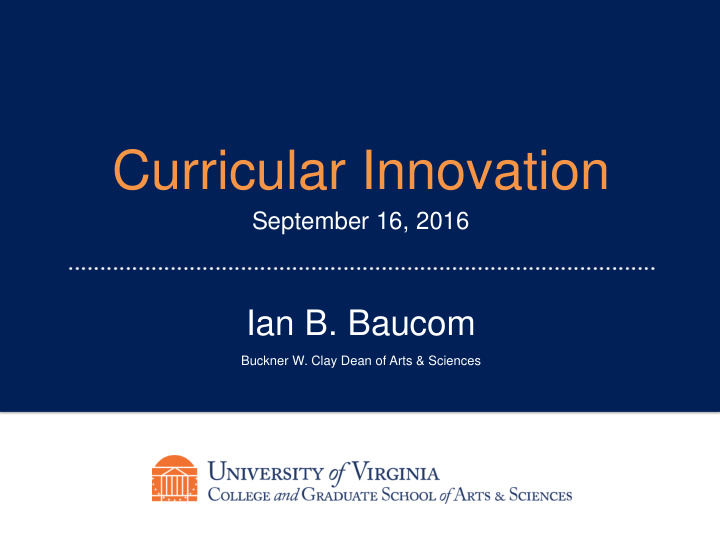



Curricular Innovation September 16, 2016 OPTIONAL SUBHEAD HERE Ian B. Baucom Buckner W. Clay Dean of Arts & Sciences
TODAY’S TOPICS 1. Purpose 2. Framework 3. Timeline Slide Number
OUR PURPOSE A liberal arts & sciences education should: 1. Prepare students for engaged citizenship—locally, nationally, and globally; 2. Equip them for lives of purposeful vocation in a dynamic, rapidly-changing world; 3. Enable their individual human flourishing; 4. And ready them to contribute to the flourishing of the Commonwealth and the global common good. Slide Number
WHAT DOES THIS REQUIRE? 1. Students considering the ethical implications of their commitments, as citizens and in their vocations 2. Students formulating hypotheses, testing empirical questions, and making reasoned and analytic claims 3. Students engaging the arts as a fundamental avenue to knowing and being in the world 4. Students understanding the breadth of human diversity and difference Slide Number
WHAT DOES THIS REQUIRE? 5. Students ready to live and work in a world of many languages 6. Students mastering written, oral, and digital forms of expression 7. Students understanding data and problem-solving from an analytical and quantitative perspective 8. Students thoughtfully exploring and connecting knowledge across the full range of liberal arts and sciences disciplines Slide Number
CURRICULUM FRAMEWORK MAJOR (30+ Credits) Slide Number
ENGAGEMENTS 1. Aesthetic Engagement 2. Empirical & Scientific Engagement 3. Engaging Difference 4. Ethical Engagement Students enroll in 4 Engagement courses during their first-year • Each course is 2 credits • Meets for half of a semester (7 weeks) • Taught by the College Fellows Slide Number
COLLEGE FELLOWS • A College-wide body of rotating faculty members and post- doctoral teaching fellows drawn from across departments and programs • Fellows co-design and teach the signature first-year Engagement courses • Appointments are for fixed terms • Inaugural cohort is 12 Fellows • If the curriculum pilot is affirmed for all students, the cohort will scale to ~40 Fellows Slide Number
LITERACIES 1. World Languages Equivalent of two years of study (up to 14 credits) 2. Rhetoric for the 21 st Century Two courses (6 credits) 3. Quantification, Computation & Data Analysis Two courses (6 credits) Slide Number
DISCIPLINES 1. Artistic, Interpretive, & Philosophical Inquiry 2. The Chemical & Physical Universe 3. Culture & Societies of the World 4. Historical Perspectives 5. Living Systems 6. Social & Economic Systems 7. Science & Society Seven courses (21 credits) across six departments Slide Number
CURRICULUM TIMELINE May 4, 2016 Full Faculty Vote Aug 2016 Launch College Fellows Aug 2016 – May 2017 Development Phase Aug 2017 – May 2018 Initial Cohort Launch (~500 students) May 2018 Assessment Review and Report to Faculty Aug 2018 – May 2019 Expanded Cohort Launch A (~1000 - 1500 students) May 2019 Assessment Review and Report to Faculty Aug 2019 – May 2020 Expanded Cohort Launch B (~1000 - 1500 students) Aug 2020 – May 2021 Full Implementation of New Curriculum Slide Number
ADVANCES IN STUDENT LEARNING DESIGN 1. Project- and Problem-Based Learning – Re-design of General Chemistry & Statistics courses 2. Flipped and Digitally-Supported Courses – Mobile app for Chinese language instruction – Physics labs 3. Focus on Digital Literacy – ePortfolios Slide Number
Recommend
More recommend